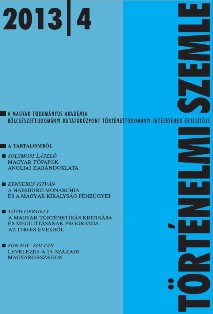Levelező vállalkozások. A levél mint műfaj a vállalkozások hétköznapjaiban a 19. század második felében és a 20. század elején
Letter-writing Enterprises. The Letter as a Genre in the Everyday Activity of Enterprises in the Second Half of the 19th Century and the Early 20th C.
Author(s): Judit KlementSubject(s): History
Published by: Magyar Tudományos Akadémia Bölcsészettudományi Kutatóközpont Történettudományi Intézet
Summary/Abstract: In the 19th and 20th centuries the letter was the dominant form of communication among the enterprises. It was used not only for the communication and exchange of news, but also as an early way of advertising, and with various techniques. The letter conquered various areas and assumed highly developed forms among the enterprises from as early as the middle of the 19th century. Some of its types are still known and used today while most people are not aware of their centuries old history. By studying the individual types of letters we gain an insight into the building and running of enterprises in the 19th and 20th centuries. Yet an approach to this topic is hindered by the fact that no complete correspondences of great companies, let alone those of smaller enterprises, have survived, and it is thus impossible to reconstruct on the sole basis of business papers the forms of letter use in the 19th century; indeed, it is highly probable that the surviving archival sources would fail to permit a complete view even for first half of the 20th century. Nevertheless, we do possess for the study of this topic a special group of sources, namely the schoolbooks and manuals used for the teaching of business correspondence. In accordance with its contemporary importance, correspondence was taught as a separate subject in business education, and collections of samples were published not only for students but also for practicing businessmen. On their basis a more reliable picture can be drawn about correspondence among the enterprises in the 19th and 20th centuries, which was complemented from the late 19th century by the internal communication within the great companies, where the tasks and competences were already arranged into a business hierarchy. In the everyday activities of enterprises the letter was simultaneously a means of maintaining connections and advertising, as well as business-like and personal. It can safely be stated that from the mid-19th century both the importance and the volume of correspondence and literacy increased sharply in the running of businesses. That it was so is proved by the great variety of letter forms and the differentiated use of the letter types. Although personal communication remained an important part of business life, in its routine workings correspondence became dominant. It was used for establishing and maintaining contacts, making and getting business, advertising, direction and in-company communication alike. In the first part of my study I examine the theory of business correspondence in the 19th and 20th centuries, also positioning the subject within the system of education, then proceed to the questions of the practice of correspondence, touching upon other forms of communication as well.
Journal: Történelmi Szemle
- Issue Year: 2013
- Issue No: 04
- Page Range: 639-655
- Page Count: 17
- Language: Hungarian

